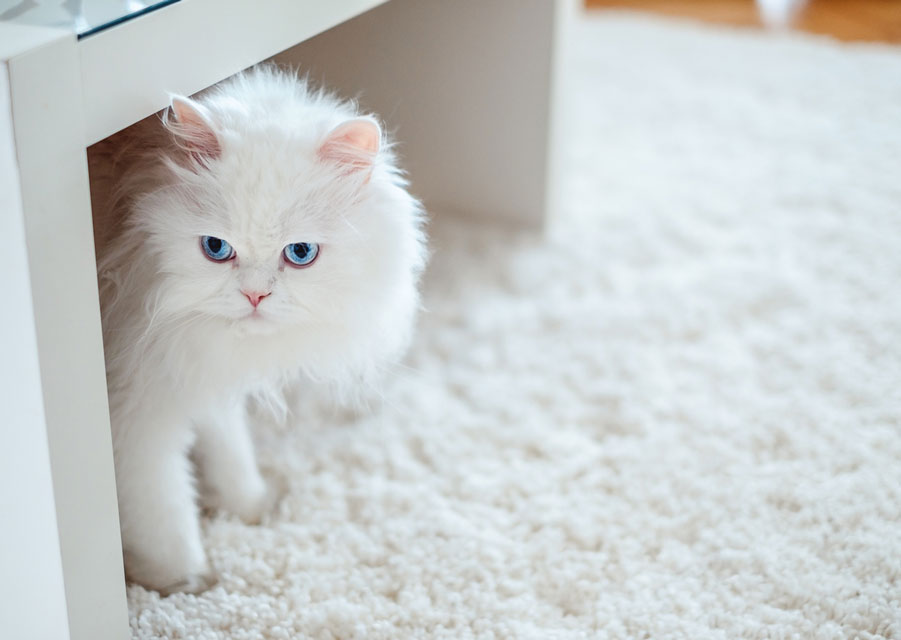Tips for Keeping Your Indoor Cat Mentally Stimulated

Indoors is the safest place for a cat, but it is crucial that you provide enough mental stimulation to keep your indoor cat from becoming bored or stressed. Also, it's important to make sure that he gets enough exercise and doesn't become overweight.
Interactive Play Is Critical for Indoor Cats
Playtime is crucial for keeping an indoor cat mentally happy, physically healthy, and content to be inside. Make a habit of playing with your cat for at least 10 minutes a day. Kittens and some rambunctious cats require more than that.
The best type of play for keeping a cat happy is interactive, where you use a toy to mimic the behavior of a cat's prey animals, either birds or rodents. Wand toys are exceptionally good for this. Make the toy on the end of the wand act like scared prey, darting away from your cat, hiding, and freezing in fear. Don't make the game too easy, but do let your cat catch the "prey" sometimes, especially at the end of the game, after which you should reward your cat with a treat or meal. That is, after all, what would happen after a successful hunt in nature. Learn more here: "Can Special Playtime Decrease Problem Scratching?"
Good Scratching Posts Are a "Must"
Cats scratch to exercise, destress, and mark their territory. If they don't have good scratching posts, they can become stressed and exhibit negative behaviors, like urinating and scratching inappropriately. A good scratching post means:
- Sturdy, so there's no chance of it wobbling or falling over when the kitty leans into it.
- Tall, so the cat can fully stretch his body all the way up it for a good back stretch,
- Covered in material that doesn't catch and pull on claws and is satisfying to scratch. Sisal fabric and heavy corrugated cardboard are the best scratching substrates for cats.
The posts at PurrfectPost.com are designed to fit all of these criteria. Get some good posts, trees, and condos, and put them in high-traffic areas of your home, so your cat can mark his territory and show it off to everyone who enters.
Let Your Cat Hunt for Food
Interactive play, when your cat can chase a wand toy that acts like prey as described above, helps cats indulge their hunter instincts. You can further encourage this by breaking your cat's daily food allotment into smaller sections and hiding these around the house every day so your cat must stalk and hunt his food. Not only does this get him a little extra exercise, but it also provides mental stimulation, especially if you're gone for the day. When you first begin to do this, you might need to encourage your kitty to find the food, guiding him along, until he understands what you've done and what he needs to do to get his food every day.
You can also put some of your cat's kibble into a puzzle toy that he can work on throughout the day. This is a lot of fun for a cat and can keep his mind occupied for a while. It also decreases the calories that your cat is getting all at once.
Get New Toys Routinely
Cats can and do get bored with the same toys all the time. You can mitigate this by having a box of toys that you keep out of reach of your cat and bring out a few at a time, rotating them routinely. Also, wand toys should be put away after an interactive play session for a couple of reasons:
- Your cat will view a wand toy lying on the floor as "dead prey" and won't be impressed if it suddenly comes back to life.
- There is some danger associated with leaving wand toys out in case your cat becomes entangled in the string part while you're not there to supervise.
You can sometimes revitalize old toys by spraying them with catnip or honeysuckle spray. This technique can renew your cat's interest in a toy that he's gotten bored with and is ignoring.
Get new toys often, too, to keep your cat interested and engaged in play. You can get catnip or honeysuckle toys, depending on which your cat responds to better, ball toys, and wand toys, to keep as much variety as possible in your cat's daily play routine.
Maximize the Space You Have
When your cat stays inside, it's important to maximize the enrichment that he gets out of the space. Provide kitty hiding spots like Cat Caves because cats love to hide and watch what's going on with a feeling of being invisible.
Many cats also like to hang out up high, so they can watch what's going on below them without being involved in it if they don't want to be. You can provide tall scratching posts and cat trees, clear off space on high shelves (just be sure they're bolted to the wall for safety) or the refrigerator top, and some people even build elaborate cat walks near the tops of their walls for their cats to enjoy.
If you live in a small home, look for tips on how to maximize the space for your cat here: "Make Your Small Space into a Feline Haven."
Keep Entertainment Available When You Aren't Home
Indoor cats can become bored when you aren't home. You can help mitigate that by hiding their food in portions as described above, and you can also get an automatic cat toy with a "play while you are away" function. These toys can be set to turn on randomly and give your cat something to anticipate and enjoy while he's home alone.
You can also provide entertainment to your cat by placing a cat tree with a lounging platform near a window and then mounting a bird feeder outside of that window. Your cat will love to sit and watch the birds while you're gone. Just be sure to put the feeder far enough away from the window that the birds aren't spooked by the kitty.
Consider a Catio or Other Enclosed Outdoor Space
You can buy or build an enclosure called a catio that makes going outside safer for your indoor cat. These can provide wonderful enrichment opportunities for indoor cats. Remember that simply letting your cat out into a fenced-in yard might not be safe because your cat might jump over the fence and it also won't necessarily keep predator animals or other cats that could be a threat to your kitty out of the yard.
Teach Your Cat to Walk on a Leash
Some cats can be trained to walk with a harness and leash outside, and then you can make a habit of getting out there with your cat routinely, to provide him with some fresh air and a change of scenery. Here are some general guidelines for doing this:
- Get your cat used to wearing a harness and leash inside by putting them on (supervised only) for short periods of time. Be sure you choose a well-made set with solid buckles, and replace them promptly if they become worn.
- Put visible ID tags with your current information on the harness, just in case your cat gets away from you. Having your cat microchipped is a good idea, too.
- Always be sure you have a good hold on the leash and aren't distracted by anything while walking your cat outside, so you're ready to respond if something happens to scare your cat and potentially cause him to try and bolt away.
If your cat is scared or doesn't like the harness and leash, slow down with getting him used to them. Some cats simply don't like going outside, so you shouldn't push it, but many cats can be trained to walk on a leash with time and positive reinforcement.
You May Also Like These Articles:
5 Ways to Tell If Your Cat Is Stressed (and Tips for What to Do)
Can Special Playtime Decrease Problem Scratching?


